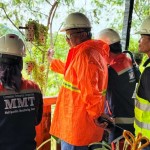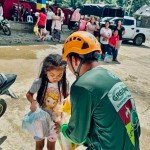-
Soaked in water. Close to 3,000 residents flee from their homes in search of safer ground as flood water submerged crops and several houses while landslides isolated the town from the rest of Zamboanga Peninsula.
-
Intertropical Convergence Zone (ITCZ) rampages in Siocon and triggers the swelling of Pisawak River, cutting off the spillway that directly connects the town to the rest of the Peninsula.
-
Flood water submerges Siocon Municipal Hall at the heart of the town.
-
The northern approach of the town’s Mendiola Bridge – Siocon’s oldest bridge – is not spared from the destruction brought by massive rainfall.
-
Almost 3,000 residents flee from their homes and are safely housed at the town’s cultural and exhibition center where volunteers prepare and cook food for the evacuees.
-
TVIRD’s Engr. Edilberto J. Nercuit, (foreground) and the company’s engineering crew brave the harsh weather, clearing and repairing the roads damaged by landslides.
-
TVIRD committed to mobilize the company’s fleet of heavy equipment to clear the roads from tons of loose soil, boulders and trees as well as rip-rapping big cracks and pot holes on the roads to allow for the passage of vehicles.
-
The Provincial Disaster Risk Reduction and Management Council (PDRRMC) came to the rescue, bringing rubber boats to ferry stranded residents from their homes to the evacuation sites.
-
PDRRMC head, Christopher Zoza, and his crew operate the rescue boats sent by the provincial government, safely transporting almost 300 stranded passengers from Barangay Pisawak to the other side of the riverbank and vice versa.
Siocon, Zamboanga del Norte / October 2013 – Six days of heavy rain brought by the Intertropical Convergence Zone (ITCZ) battered this municipality touted as one of Zamboanga del Norte’s prominent food baskets. According to PAG-ASA Regional Director Maribel Jasana-Enriquez, the ITCZ was “trapped” and was strengthened by a low pressure area (LPA) in Virac, Catanduanes, thus resulting in heavy rains, especially in Northwestern Mindanao. Nearly 3,000 Siocon residents fled from their homes, seeking safer ground as flood water destroyed crops and submerged several houses while landslides isolated the town from the rest of Zamboanga Peninsula. Eight major landslide occurrences hampered rescues efforts to the remote town as inland transport was constrained to a standstill.
Isolation and power outage
Power was cut-off, plunging the entire town into darkness as electric posts of local power company, Zamboanga del Sur Electric Cooperative (ZAMSURECO) ll, were pummeled by strong winds and fell down.
“For three straight days, my town was isolated from the rest of the region. It seemed we were so alone, helpless and (with) no hope of any help from either the government or private sector. But thanks to TVIRD, which cleared and repaired the roads, we now have the help we need the most,” said Siocon Mayor Julius Lobrigas who was among those stranded due to the swelling of Pisawak River, which cut-off the spillway that directly connects the town to the rest of the Zamboanga Peninsula.
The alternate route, the Labason-Gutalac-Baliguian-Siocon provincial road was also cut-off due to several landslides.
Swift response and rescue
TVIRD Civil Engineering Services Manager Engr. Edilberto J. Nercuit and the company’s engineering crew endured the rains to clear and repair the roads damaged by landslides. Nercuit, a native of Siocon, mobilized the company’s fleet of heavy equipment to remove tons of loose soil, boulders and trees. Big cracks and pot holes on the roads were also rip-rapped to allow for the passage of vehicles.
Nercuit disclosed that the 74-kilometer stretch of roads that connects the provinces of Zamboanga Sibugay and Zamboanga del Norte were not passable to any type of vehicle because of 25 recorded landslides – eight of which were major occurrences.
Head of the Provincial Disaster Risk Reduction and Management Council (PDRRMC) Engr. Christopher Zoza was able to bring in rescue boats for ferrying stranded residents as well as plastic mats and thermal blankets on Monday, October 7 – exactly three days since the onslaught of heavy rains. The next day, TVIRD provided trucks to transport rice and sardines from the Department of Social Welfare and Development (DSWD) in Zamboanga City and medicines from the Department of Health (DOH).
“We are able to help Siocon because of the assistance also of TVIRD. Without its help, we could not have reached Siocon and assisted the people,” said Zoza whose crew manned the rescue boats sent by the provincial government.
Impact on livelihood and infrastructure
An initial report from Siocon Mayor Julius Lobrigas last October 8 revealed that damage to agriculture and infrastructure had already reached Php136.40 million while a total of 5,517 families were affected in 23 out of 26 barangays of the town.
Located at the southernmost part of the province, Siocon is an agricultural town that relies on farming as its citizens’ main source of living while fishing provides additional livelihood since its seas are abundant with different species of fish. Siocon has been declared as one of the province’s rice granaries by the Department of Agriculture (DA).
Also rich in natural resources, Siocon hosted TVIRD’s gold-silver mining operation from 2004 until 2008 in Sitio Canatuan. Currently, the company is conducting copper and zinc mining operations in the area – which is set to wrap-up by the end of the year.
As TVIRD’s engineering crew continues to work in order to make Siocon accessible to the government’s relief assistance, General Manager Germidas Las Pinas assured the town’s people that the company will, at all times necessary, continue to assist in the government’s unhampered delivery of relief operations.
“We are committed to be of assistance, especially in this time of great need,” he said. Since its establishment in Siocon, the company has been the town’s partner in sustainable development.
Flooding due to natural phenomenon
On his part, TVIRD Environment and Civil Works Vice President Engr. Jay Nelson noted that the Sulphide Tailings Storage Facility is safe and free from any indication of failure of either dam or spillway. Both structures were designed and constructed to meet very stringent engineering criteria and can withstand more severe conditions. Inspection of the dam and spillway indicate that both are operating as designed and are fully stable.
The maximum 24-hour rainfall experienced recently was 302 mm. TVIRD’s dam and spillway are designed to safely operate for a 24-hour rainfall of 1,635 mm – which is over five times the rainfall recently experienced. Analysis of the rainfall data collected at Canatuan since 1994 indicate the current rainfall event is equal to a return period between 50 to 100 years. While this is the largest rainfall event experienced at Canatuan since record keeping began, it is well within the design parameters of the dam and spillway.
Nelson noted that some reports suggest the release of water from the dam and spillway are the cause of flooding downstream. This is not the case as the facility does not store stormwater. Water that comes into the dam is immediately discharged from it through the spillway. There are no controls and no structures that allow for the storage of water from rainfall events of this magnitude or less. The downstream flooding in Siocon is a result of natural rainfall conditions.
Typhoon Lawin, which set a new record for Siocon, submerged almost 70% of the town last year, according to the report of former Mayor Cesar Soriano to the regional director of the Office of Civil Defense (OCD) in Zamboanga Peninsula. It also set the highest record of rainfall for nine consecutive years. In the same report, the former mayor also said that in 1952 and in the 70’s, Siocon was hit by typhoons more destructive than Lawin in 2012.
Zero casualties, hope for Siocon
Incumbent first-term Mayor Lobrigas added that despite the heavy damage his municipality suffered, he is thankful to God that no one was hurt and no lives were lost during the week-long catastrophe.
“We are badly hit, but I know we will weather the storm with the help of God and everyone in Siocon. We can rise up again,” Lobrigas said.
Download PDF
Download Word Document












